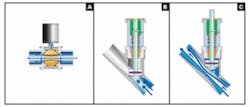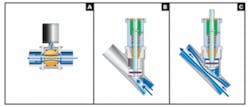Are Ball Valves the Best Choice? - Not Necessarily
By Joe Vandehey
The ball valve has been a mainstay of industrial water treatment for 50 years. Originally invented for use in firefighting systems aboard U.S. Navy vessels, the ball valve was designed for nearly instantaneous on/off, high-pressure/maximum velocity flow with little or no pressure drop (i.e., zero restriction).
But as any of you who have used actuated ball valves for any length of time knows, these valves are notoriously high maintenance - with relatively short lifetimes. Employing dynamic shutoff, with fluid pressure forcing the actual ball against the valve’s seat creating the seal that prevents fluid flow, an actuated ball valve’s seals experience significant wear and tear.
Seal Degradation
As a ball valve is repeatedly opened and closed, its seals (typically of Teflon), constantly rub against the valve’s inner surfaces and over time wear down. Add particulate-laden water flowing through the valve, and the seals scratch and wear that much faster. Eventually, the seals fail and start to leak, necessitating costly, time-consuming maintenance and downtime.
Under perfect conditions, you can expect up to 100,000 cycles from an actuated ball valve. But if you’re dealing with “dirty” steam or water, you can expect this to be shortened significantly. The combination of the particulate-laden steam/water and very high temperatures can quickly degrade valve seals and other components, often limiting ball valve life in these scenarios to only a week or two.
Yielding to Alternatives
To overcome the ball valve’s shortcomings - while retaining key ball valve benefits - manufacturers have experimented with other valve designs. One of the most successful of these is the Y-pattern or angle isolation valve, which Burkert introduced in 1991. Scores of other valve manufacturers have come out with their own versions in the years since.
The piston-driven Y-pattern valve permits flow rates nearly equal to those of ball valves, line size for line size. (Keep in mind that most ball valves aren’t “full port” in design, with the aperture through the ball itself slightly narrower than the diameter of the pipe attached to the valve.) Where Y-pattern and ball valves do differ are in the areas of maintenance and valve life. While actuated ball valves are built around dynamic shutoff, as we’ve already discussed, Y-pattern valves employ static shutoff.
Spring-loaded
Controlled by a pneumatically operated single- or double-acting actuator and spring assembly, a Y-pattern valve’s piston is raised to open flow and lowered into the valve seat to shut off (isolate) flow completely. As the Teflon seal at the piston tip relies on static spring or air pressure to maintain contact with the seat, a Y-pattern valve and its seals don’t experience the wear-and-tear of actuated ball valves. The benefit here is that a Y-pattern valve’s expected lifetime is 5 million cycles on average. In particulate-laden industrial water applications, the reductions in maintenance time and equipment replacement costs achieved by using Y-pattern valves in place of ball valves add up to significant numbers.
It’s also important to note that not all actuated ball valves come with live-loaded stem packing - as do most Y-pattern piston valves. Live-loaded stem packing, with a spring incorporated to maintain pressure on the packing, compensates for wear caused by valve actuation. IWW
About the Author: Joe Vandehey is an industry segment manager for Irvine, Calif.-based Burkert, which emphasizes a systems approach to fluid control solutions. Vandehey has extensive experience in water treatment applications and 17 years of fluid control experience overall. He can be reached at 951-506-3477, [email protected] or www.burkert-usa.com.

